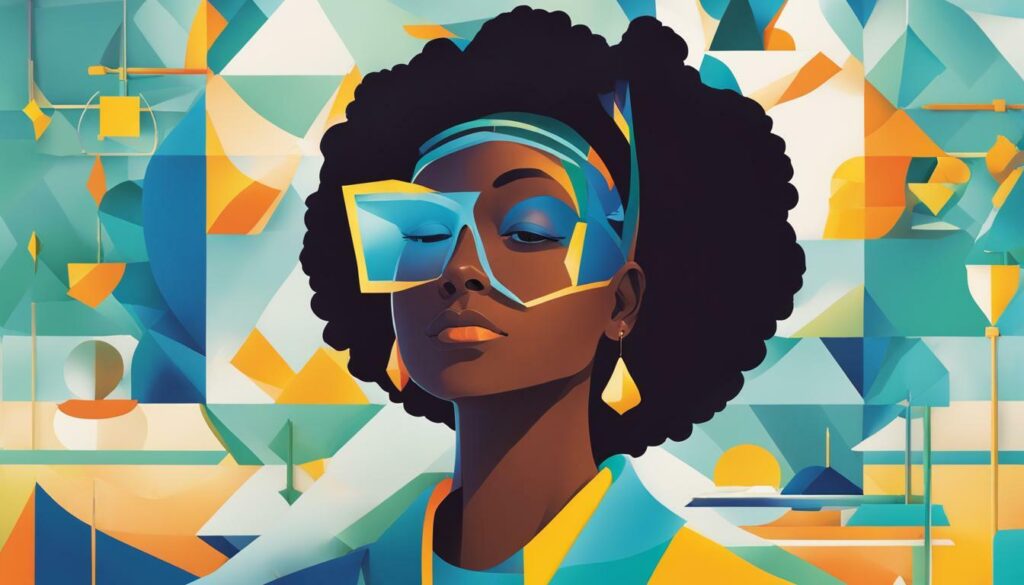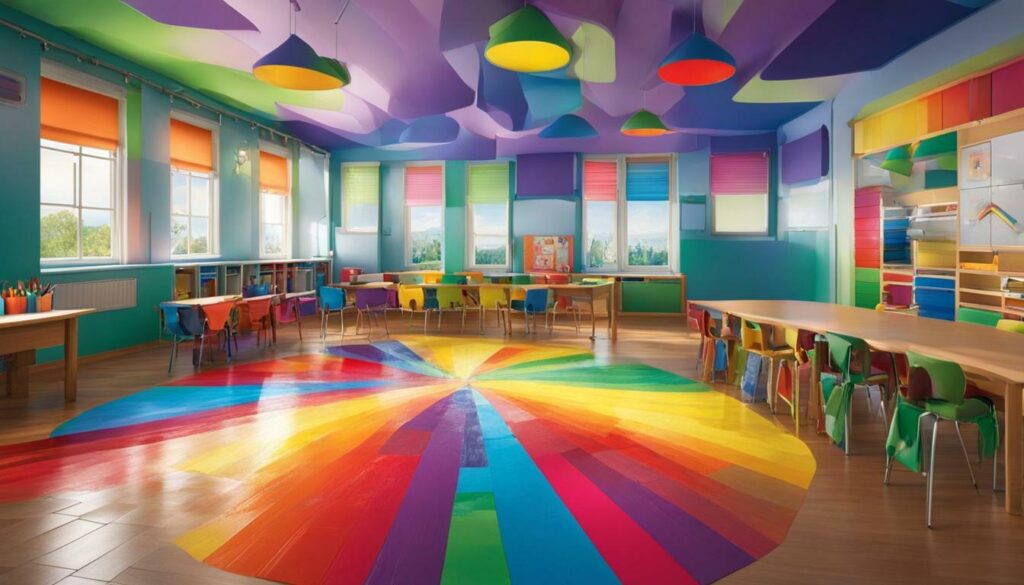Welcome to our educational journey into the realm of Color Therapy for Learning. In this article, we will explore how the use of color can enhance the learning experience and improve information retention. By utilizing different hues, we can optimize the learning process and unlock the full potential of our minds.
Key Takeaways:
- Color therapy, also known as chromotherapy, utilizes color to improve physical and mental health.
- Using color cues, such as different colors for topics and sub-topics, can aid in information retention and enhance memory.
- Specific colors like red, green, blue, yellow, and orange have different effects on concentration, creativity, mood, and stimulation.
- Research suggests that color-based methods can be effective in improving learning outcomes, particularly in distance learning environments.
- Further research and the development of educational materials using color effects are recommended to enhance student perception and retention.
Understanding Color Therapy and its Benefits
Color Therapy, also known as chromotherapy, is the use of color to improve physical and mental health. In the context of learning, color can be utilized to enhance memory, attention, and concentration. By incorporating different hues into the learning environment, we can create a more engaging and effective educational experience.
Color psychology plays a crucial role in color therapy for learning. Different colors have unique effects on our emotions and cognitive processes. For example, red is known to stimulate the brain and increase alertness, making it an excellent choice for highlighting key points or using red ink or paper when taking notes. Green, on the other hand, promotes focus and concentration, making it ideal for study spaces or using green markers to underline important information.
Blue is associated with calmness and tranquility, which can enhance creativity and problem-solving abilities. Incorporating blue elements, such as blue walls or blue folders for organizing study materials, can create a conducive environment for brainstorming and critical thinking. Additionally, yellow is known to stimulate mental activity and can be used to highlight important information in textbooks or study guides.
While each color has its own benefits, it’s important to note that color therapy is most effective when used in combination. Purple, for instance, can be used in conjunction with other colors to create a balanced and harmonious learning environment. By incorporating a variety of colors, educators and students can optimize the learning experience and promote better information retention.

Research on color therapy in education is still limited but suggests that color-based methods can have a positive impact on learning outcomes, particularly in distance learning environments. By utilizing color cues, educators can help students remember and recall information more effectively. The strategic use of color in educational materials and resources can enhance student perception and retention.
To fully harness the power of color therapy in education, further research is needed to understand the specific effects of different colors on various aspects of the learning process. Additionally, the development of educational materials that incorporate color effects is recommended to maximize the benefits of color therapy for cognitive development. By embracing the potential of color therapy, we can create a more vibrant and engaging learning environment that supports student success.
| Color | Benefits |
|---|---|
| Red | Stimulates alertness and memory |
| Green | Improves focus and concentration |
| Blue | Enhances creativity and problem-solving |
| Yellow | Stimulates mental activity and highlights important information |
| Purple | Creates balance and harmony when used with other colors |
In summary, color therapy for learning offers a unique approach to optimize the learning experience. By understanding the effects of different colors on our cognitive processes and emotions, educators and students can harness the power of color to enhance memory, attention, and concentration. Using color cues, such as incorporating various hues for different topics and sub-topics, can aid in information retention. While further research is needed, the potential of color therapy in education is undeniable. Let’s explore the vibrant world of color therapy and unlock its benefits for improved learning outcomes.
Enhancing Memory and Attention with Color Cues
Color cues can play a significant role in enhancing memory and attention during the learning process. By incorporating different colors for topics and sub-topics, students can improve their information retention and recall. When it comes to utilizing color therapy for better learning outcomes, consider the following techniques:
- Use red ink or paper to emphasize key points. Red is known to stimulate the brain and increase alertness, making it an excellent choice for highlighting important information.
- For tasks that require concentration, incorporate green into your study materials. Green is associated with balance and harmony, which can help students stay focused and engaged.
- When aiming to foster creativity, turn to the color blue. Blue is known to enhance mental clarity and promote a calm and relaxed state of mind, allowing students to think outside the box.
Yellow is an attention-grabbing color that can be used to highlight significant details. Whether it’s underlining important concepts or using yellow sticky notes, this vibrant hue can draw students’ focus to crucial information.
Another color that can contribute to a positive learning environment is orange. Orange is associated with warmth, enthusiasm, and optimism. Incorporating orange elements, such as study aids or classroom decor, can create a welcoming atmosphere and uplift students’ moods.

“Color cues have the potential to transform the learning experience, making it more engaging and memorable for students. By harnessing the power of different hues, educators can create a dynamic environment that caters to students’ needs.”
Color Therapy in Action: A Practical Example
Let’s imagine a biology class where the teacher is explaining the respiratory system. Using color cues, the teacher could use red for the topic title and key concepts, green for sub-topics related to the lung and nose anatomy, blue for explanations of the gas exchange process, and yellow to highlight important terms or facts. By incorporating color therapy techniques, students are more likely to retain and recall the information effectively.
| Color | Associated Effect |
|---|---|
| Red | Stimulates alertness and enhances focus. |
| Green | Promotes concentration and balance. |
| Blue | Enhances creativity and mental clarity. |
| Yellow | Grabs attention and highlights important details. |
| Orange | Creates a welcoming and uplifting atmosphere. |
It’s important to note that while color therapy can have positive effects on learning, it should be used in conjunction with other effective teaching techniques. Further research and exploration of color-based methods are recommended to fully understand and unlock the potential of color therapy in education.
Harnessing the Power of Specific Colors
Each color has a unique effect on our cognitive processes, influencing our ability to learn and retain information. When it comes to color therapy in education, understanding the impact of specific colors can help educators create a conducive learning environment and enhance student engagement. Let’s explore some key colors and their effects on learning.
Red
Red is known for its stimulating and energizing properties. Research suggests that incorporating red into educational materials, such as using red ink or paper, can help students remember key points more effectively. The color red is believed to increase attention and alertness, making it beneficial for activities that require focused concentration.
Green
Green is associated with balance, harmony, and tranquility. By incorporating green elements into the learning environment, students can experience improved concentration and calmness. Green has a soothing effect on the mind and can reduce stress, creating an atmosphere conducive to learning and information retention.
Blue
Blue is known to promote creativity and enhance mental clarity. Incorporating shades of blue into educational materials or using blue lighting in the learning environment can improve cognitive performance. Blue has a calming effect and can help students relax, enabling them to think more creatively and generate innovative ideas.
Yellow
Yellow is a vibrant and attention-grabbing color. It stimulates mental processes and promotes clarity of thought. By using yellow to highlight important information or key concepts, educators can draw students’ attention to crucial details. However, it is important to use yellow strategically and sparingly to avoid overwhelming the learners.

Orange
Orange is an inviting and mood-lifting color. Incorporating orange elements in the learning environment can create a welcoming atmosphere and enhance learners’ mood. The color orange is believed to increase enthusiasm and motivation, providing students with a positive mindset for their educational journey.
In summary, color therapy in education offers a unique approach to optimize learning experiences. By understanding the effects of specific colors, educators can strategically incorporate them into educational materials and learning environments to enhance student perception, concentration, and retention. Further research and the development of educational materials utilizing color therapy effects are recommended to unlock the full potential of this innovative approach in educational settings.
The Role of Color Therapy in Education
Color therapy has the potential to revolutionize education by creating visually stimulating and conducive learning environments. In today’s increasingly digital world, where distance learning has become the norm, incorporating color-based methods and materials can greatly enhance the learning experience.
When used strategically, color can have a profound impact on memory, attention, and overall cognitive development. By utilizing different colors for topics and sub-topics, educators can help students retain information more effectively. For example, using red ink or paper to highlight key points can make them more memorable, while green can promote focus and concentration. Blue, on the other hand, has been shown to unleash creativity and inspire critical thinking.

| Color | Effects |
|---|---|
| Red | Enhances memory retention |
| Green | Improves concentration and focus |
| Blue | Boosts creativity and critical thinking |
Other colors, such as yellow and orange, can play a role in creating a welcoming and mood-lifting environment for students. Yellow is a stimulating color that can be used to highlight important information, while orange can promote a positive mood and increase productivity. It’s worth noting, however, that purple should be used in conjunction with other colors, as it can have a calming effect but may not be as effective on its own.
While research on color therapy in education is still limited, preliminary studies suggest that incorporating color-based methods can lead to improved learning outcomes. By utilizing colors strategically in educational materials and learning spaces, educators can create an engaging and stimulating environment that enhances student perception and retention.
Future Directions and Recommendations
While research on color therapy in education is limited, there is a need for further exploration and development to fully harness its potential for cognitive development in learners. The use of color in educational settings has shown promising results in improving learning outcomes, particularly in distance learning environments.
One future direction for investigation is to conduct more rigorous studies on the impact of color therapy on learning. By examining the effects of specific colors on different cognitive processes, researchers can gain a better understanding of how to optimize color-based interventions in classrooms.
To fully integrate color therapy into education, the development of educational materials utilizing color effects is essential. This includes designing textbooks, online resources, and instructional materials that incorporate appropriate color cues to enhance information retention and engagement.
Furthermore, collaboration between educators, psychologists, and designers is crucial to ensure the effective implementation of color therapy techniques in educational settings. By working together, they can develop evidence-based strategies and create environments that promote optimal learning experiences for students.
FAQ
What is color therapy?
Color therapy, also known as chromotherapy, is the use of color to improve physical and mental health. In the context of learning, color can be utilized to enhance memory, attention, and concentration.
How can color cues improve learning?
By using different colors for topics and sub-topics, students can remember information better. For example, using red ink or paper can help students remember key points, while green can improve concentration and blue can promote creativity.
Which colors are beneficial for learning?
Different colors have different effects on learning. Yellow is stimulating and can be used to highlight important information, and orange can create a welcoming and mood-lifting environment. Purple should be used in conjunction with other colors for optimal benefit.
Is there research supporting color therapy in education?
Research on color therapy in education is limited but suggests that color-based methods can be effective in improving learning outcomes, particularly in distance learning environments. Further research and the development of educational materials using color effects are recommended to enhance student perception and retention.




